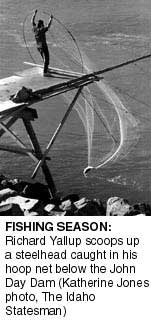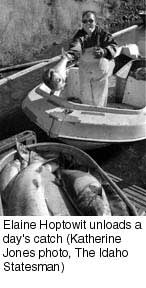forum
library
tutorial
contact

Tribes Cast for Tradition, Catch Controversy
by Rocky BarkerHigh Country News, December 20, 1999
|
the film forum library tutorial contact |

|
Tribes Cast for Tradition, Catch Controversyby Rocky BarkerHigh Country News, December 20, 1999 |
 ARLINGTON, Ore. - Elaine
Hoptowit has barely thrown the
last salmon from her boat into
a cooler in her pickup truck
when customers show up.
Wearing yellow rubber
overalls, the Pocatello, Idaho,
grandmother lifts from the
truck a 17-pound chinook
salmon she has pulled out of a
gill net on the Columbia River
only minutes before.
ARLINGTON, Ore. - Elaine
Hoptowit has barely thrown the
last salmon from her boat into
a cooler in her pickup truck
when customers show up.
Wearing yellow rubber
overalls, the Pocatello, Idaho,
grandmother lifts from the
truck a 17-pound chinook
salmon she has pulled out of a
gill net on the Columbia River
only minutes before.
"It's $2 a pound, but I'll give it to you for $30," she tells Curtis Floyd, of Molalla, Ore.
"If you'll clean it for me," he says.
Using a borrowed knife, she guts and cleans the fish, continuing a tradition Indians have carried out for thousands of years, catching and trading salmon from the Columbia River. Hoptowit, a member of the Yakama Nation, returns every year in late August through mid-September to the desolate landing at Blalock Canyon, 30 miles east of The Dalles, Ore., for the annual fall chinook run.
It's the only time of the year when members of four Columbia River tribes, the Yakama, the Nez Perce, the Umatilla and Warm Springs, are allowed to place gill nets into the river to catch salmon and steelhead as the fish make their way upriver to spawn. Today, the fishing is a tradition as important to them as the annual fall cattle roundup is to Western ranchers.
"It's just like Christmas, it comes every year," says Hoptowit.
But it is a tradition that rankles non-Native fishermen and other river users.
"We catch a wild steelhead, release it, and they catch it in a net, knock it on the head and sell it back to us," says Jerry Larsen, fishing just below John Day Dam. "It's absurd."
A complicated history
The tribes have fished the Columbia for hundreds of generations, but their right to fish in modern times was secured by the treaty of 1855, when the tribes ceded most of Oregon, Washington and Idaho to the United States. They retained the right to fish in the "usual and accustomed places."
As the number of fish declined from millions to thousands, the competition for Columbia salmon and steelhead increased. In the mid-1970s, the tribes won court cases that gave them the right to take 50 percent of all the fish caught in Washington and Oregon. Indian and non-Indian fishermen clashed violently at times along the banks of the river, fighting over a steadily declining number of fish.
The violence ended by the early 1980s, but the emotions have not diminished. In fact, the listing of four runs of Snake River salmon and steelhead in the 1990s has intensified the conflict recently, as Indian and non-Indian fishermen fish side-by-side under different rules. This year, Hoptowit says she brushed off the occasional rude comments from customers. But camping at the isolated landing, often with only her elderly uncle Willard Kaninie, she faced more intimidating acts.
"We had a car down here, spinning around, calling us names belligerently," she says.
 Many farmers, grain shippers
and other river users share the
view that the gantlet of hooks,
nets and lures that salmon must
run from Alaska to Idaho is a
major cause of the salmon's
decline.
Many farmers, grain shippers
and other river users share the
view that the gantlet of hooks,
nets and lures that salmon must
run from Alaska to Idaho is a
major cause of the salmon's
decline.
Most of the fish Hoptowit and the other tribal fishers catch are Columbia River fall chinook that spawn in the Hanford Reach near Richland, Wash. This population of salmon is healthy, with several hundred thousand adults expected to return to spawn this year.
But at the same time, anywhere from 1,000 to 1,500 endangered fall chinook that spawn in the Snake River and thousands more endangered steelhead are in the river. Gill nets are not selective; inevitably, tribal fishermen take some of these fish.
Most scientists say that fishing has had little effect on the 30-year decline of Snake River salmon runs. They note that fishermen catch less than 10 percent of the Snake River's annual run of wild spring/summer chinook.
"In the 1950s and '60s, half of the spring/summer chinook were taken by fishermen in the Columbia River, yet Idahoans could still catch fish and have enough left over to sustain the species," said Ed Bowles, Idaho Department of Fish and Game anadromous fisheries manager.
But others say it makes no sense to let Indians catch endangered fish. The more than $400 million spent annually to save endangered Snake River salmon and steelhead overwhelms the estimated $1 million tribal fishermen will make, says Bruce Lovelin, director of the Columbia River Alliance, a Portland-based coalition of industries and commercial interests.
The alliance wants to pay the tribal fishermen as much as $5 million a year to keep them from fishing, thus allowing more endangered salmon and steelhead to return to Idaho.
"Paying $2 a pound for these fish is ridiculous," Lovelin says.
Taste the tradition
Tribal leaders are attempting to change the image of the gill-netting season and to increase the income for the 300 tribal members who annually participate. Until three years ago, the only outlet was the commercial fish market, which bought the fish for as little as 60 cents a pound. For the past three years, the tribes have conducted a marketing campaign to promote salmon sales along the banks of the river.
"Taste the tradition," the radio commercial says.
"It's definitely brought us more buyers," Hoptowit says of the marketing campaign.
But tribal fishermen say fishing has always meant far more than money. It's the essence of their culture, and for some, it's religion.
Troy Walker, a Nez Perce tribal member from Kooskia, Idaho, lay on a sleeping bag in the middle of a disheveled campsite overlooking the Columbia just below John Day Dam. With his friends, Robert McCormick of Lapwai, Idaho, and Percy Jack of Washington, he watched a hoop net hanging from a wooden scaffold built over the water.
"When it dances, we pull up the fish," Walker explains.
These fish are not for sale. They are for personal and ceremonial use, and these fishermen can fish all year. Jack, a member of the Seven Drum religion, explains that the fish are a sacred part of its traditional ceremonies.
"First there is the water, then the salmon in the water, then the deer, the roots, the berries and the water again," he says. "From the river to the mountain with water afterwards, to cleanse."
Fishing from scaffolds with hoop and dip nets was the primary fishing method for tribal fishermen before dams inundated the rapids that were the best fishing sites. The largest and most important was Celilo Falls, covered by the backwaters of The Dalles Dam in 1957.
Hoptowit says the loss of Celilo Falls was a tragedy of enormous proportions for her father. She remembers seeing Celilo as a toddler. Though she never had a chance to fish there, Hoptowit carries on the tradition upriver, beneath the black lava bluffs surrounded by sagebrush steppe where her mother, a Walla Walla tribal member, had registered her fishing sites.
She hopes to pass them down to her daughters, Evelyn Galloway and Goette Galloway Willis, and her five grandchildren who live with her in Pocatello.
"It's a part of my life," she says. "It's something we've always done."
learn more on topics covered in the film
see the video
read the script
learn the songs
discussion forum
